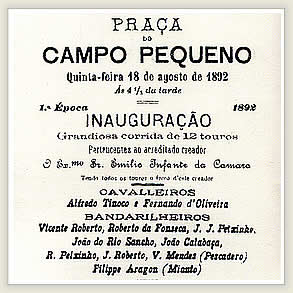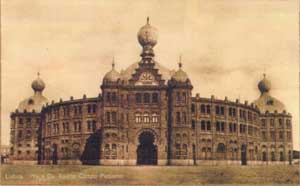
O objectivo desta cache é trazer-vos até à zona do Campo Pequeno, onde se encontra um ex libris da cidade de Lisboa, o edifício da Praça de Touros do Campo Pequeno.
História e informação
A primeira Praça de Toiros da cidade de Lisboa foi erguida na Campo Santana em 1831. O sucesso foi de tal forma assinalável que, passados alguns anos, a sua dimensão tornou-se reduzida e insegura para acolher todos aqueles que queriam assistir às corridas de toiros. Foi então cedido, pelo Município de Lisboa, um terreno baldio na zona do Campo Pequeno onde, já no século XVIII, se tinham efectuado corridas de toiros. Projectada pelo arquitecto António José Dias da Silva (1848-1912), as suas obras de construção iniciaram-se em 1891 e, a 18 de Agosto de 1892, a Praça de Touros do Campo Pequeno abriu as suas portas com uma gala com a pompa e a circunstância adaptadas à exigência deste momento alto para a cidade de Lisboa. Desde então a sua monumentalidade e beleza são emblemas da cidade de Lisboa.
Retirado de http://www.campopequeno.com/default.aspx?CpContentId=46

A Praça de Touros do Campo Pequeno é totalmente construída em tijolo, apresentando um estilo neo-árabe com cúpulas semelhantes às de mesquitas. Na verdade, o edifício é agora bem mais do que uma Praça de Touros. Esteve fechado entre 2001 e 2006 para obras de restauro e o resultado foi uma estrutura com cobertura amovível, preparada para receber espectáculos de todo o tipo (própria para ópera, concertos e teatros) e com capacidade para 8000 espectadores. O espaço tem também zonas de restauração, comércio, cinemas e um parque de estacionamento subterrâneo.

Curiosamente, ainda antes de ter sido construída a Praça de Touros, foi nesta zona que se realizaram alguns dos primeiros jogos de futebol em Portugal. Em particular, foi no Campo Pequeno que se realizou o primeiro jogo entre portugueses e estrangeiros, no dia 22 de Janeiro de 1889. Do lado dos estrangeiros, faziam parte da equipa empregados do Cabo Submarino, da Casa Graham e de outras casas inglesas instaladas em Lisboa. A equipa portuguesa foi uma selecção dos melhores jogadores da época, entre os quais alguns elementos da família Pinto Basto, a quem se atribui a introdução do futebol no nosso país.
Mais informação em http://www.cif.org.pt/Pages/Clube/Historia/Historia.htm
Durante o século passado (século XX) a zona do Campo Pequeno sofreu profundas alterações. Contudo, mantém-se em redor da Praça de Touros o Jardim do Marquês de Marialva, muito frequentado por aficionados das toiradas que aí se juntavam para as discutir. Anda ligado ao toureio o nome de Marialva, por o 4º Marquês, D. Pedro Noronha Coutinho, ter sido, além de um ilustre militar, gentil-homem do rei D. José I e estribeiro-mor de D. Maria I, um mestre da arte de cavalgar (a qual passou a ser conhecida como a "arte de Marialva") e um distinto cavaleiro tauromáquico, muito popular e com ligações ao fado e à boémia, de tal modo que motivou posteriores criações artísticas, designadamente na literatura (com Rebelo da Silva, Júlio Dantas e Cardoso Pires).
Este jardim que envolve a Praça de Touros foi inicialmente organizado em quatro espaços equilibrados. Até há pouco tempo, o espaço estava completamente decadente e votado ao abandono. Foi muito recentemente sujeito a uma intervenção de requalificação que o tornou de novo um espaço agradável. É aqui que irá encontrar esta cache.
Ainda no Campo Pequeno é possível encontrar e visitar o Palácio das Galveias. O palácio Távora-Galveias é um edifício do século XVII e é um dos melhores exemplos das casas nobres portuguesas seiscentistas. Foi mandado construir pela família Távora como casa de campo, pertenceu aos Condes de Galveias e posteriormente a um capitalista lisboeta. Após três décadas de abandono, foi adquirido, em 1928, pela Câmara Municipal de Lisboa que levou a cabo várias obras de restauro. A 5 de Julho de 1931 foram inaugurados o museu e a biblioteca das Galveias. Actualmente, aí se encontra a Biblioteca Municipal Central de Lisboa (Horário: Dias úteis: 10h00-18h45; Sábados: 11h00-17h45).
Finalmente, deve referir-se o edifício Sede da Caixa Geral de Depósitos, uma construção bem mais recente, cuja dimensão não pode passar despercebida a quem passa na zona. Para conhecer mais em pormenor este edifício, pode tentar a Cache da Caixa.
Se quiser aproveitar para ver mais alguns pormenores de interesse, pode descer até ao Metro do Campo Pequeno e apreciar as esculturas e painéis alusivos à Festa Brava que ali se encontram, da autoria do escultor Francisco Simões.

A cache
A cache está escondida no Jardim do Marquês de Marialva. O contentor é demasiado pequeno para poder receber presentes para troca, tendo no seu interior apenas um logbook e stashnote. Traga material de escrita! A cache está num local muito exposto. A vossa discrição será essencial para garantir a sua sobrevivência. Um agradecimento ao Peter por ter colaborado na manutenção de uma das versões anteriores!
Boa caçada!

The objective of this cache is to bring you to the Campo Pequeno zone, where you will find the Bull Fighting Arena (Praça de Touros) of Campo Pequeno, an ex libris of Lisboa.
History and information
The first bull fighting arena in Lisboa was built at Campo Santana in 1831. This arena was such a big success that some years later it became too small and insecure to host the large crowds that wanted to watch the bull fighting races. Because of that, the municipality of Lisbon granted a free space in the area of Campo Pequeno where, already in the 18th century, earlier bull fights had taken place. Designed by the architect António José Dias da Silva (1848-1912), the construction works of the new Bull Fighting Arena of Campo Pequeno began in 1891 and on the 18th of August of 1892 it opened its doors with the ceremonial and the pomp adequate to this so important moment for the city. Since then, its monumentality and beauty are flagships of the city of Lisboa.
Taken (and then translated) from http://www.campopequeno.com/default.aspx?CpContentId=46
The Bull Fighting Arena of Campo Pequeno is totally built with bricks, displaying a neo-arabic style with cupolas similar to those found in mosques. In fact, the building is now much more than just a bull fighting arena. It was closed between 2001 and 2006 for restoration works; the space, with a capacity for 8000 spectators, was added a movable top closure, and is now prepared to host different kinds of shows (operas, concerts…). It also includes a commercial zone, with restaurants, cinemas and a subterranean parking area.
Curiously, even before the arena was built, it was in this area that some of the first football games in Portugal took place. In particular, it was here that the first game between portuguese players and a foreign team was played, on the 22nd January 1889. The foreign team was composed of employees of Cabo Submarino, of Graham house, and of other British houses settled in Lisboa. The portuguese team was a selection of the best players at that time, among which some elements of family Pinto Basto, presumably the family that was responsible for the introduction of football in our country.
More information in http://www.cif.org.pt/Pages/Clube/Historia/Historia.htm
During the last century (20th century) the zone of Campo Pequeno has changed significantly. However, there is still the Marquês de Marialva garden around the bull fighting arena, on which the bull fighting lovers used to meet and discuss the news. The "Marialva" name is connected to the art of bull fighting, since the 4th Marquis of Marialva, D. Pedro Noronha Coutinho, a recognized military, servant of the king D. José I and also servant of D. Maria I, was a master of the art of cavalry (which was since then named as the "art of Marialva") and a distinct bullfighting horse-rider. As a popular character, his name is also connected to fado and bohemia, to the point of inspiring artistic creations, in particular in the field of literature (with writers such as Rebelo da Silva, Júlio Dantas e Cardoso Pires).
This garden all around the bull fighting arena was initially organized into four separated and balanced spaces. Until recently the space had been abandoned and decadent. Not long ago it was finally recovered and replanted, becoming a nice and pleasant place. That's where you'll find the cache.
Still in the Campo Pequeno zone you can find and visit Palácio das Galveias. The palace Távora-Galveias is a building from the 17th century and one of the best examples of the noble houses of those times. It was built by order of the Távora family as a country house. Afterward it belonged to the Counts of Galveias and after that to a capitalist from Lisboa. After three decades of abandon, it was bought in 1928 by the Câmara Municipal de Lisboa, which restored the building. On the 5th July of 1931 the museum and library of Galveias were inaugurated in this place. Currently, you will find here the Central Municipal Library of Lisboa (Timetable: Weekdays: 10h00-18h45; Saturdays: 11h00-17h45).
Finally, we must mention the Headquarters of Caixa Geral de Depósitos building, a recent construction that does not go unnoticed to whoever passes by, due to its huge size. If you want to discover this building in more detail, you should try the Cache da Caixa.
You might want to take the opportunity to see an additional interesting spot: just go down to the subway, Campo Pequeno Station, where you can enjoy the sculptures and panels illustrating the "Festa Brava", whose author is the sculptor Francisco Simões.
The cache
The cache is hidden in the garden surrounding the arena, named "Jardim do Marquês de Marialva". The container is too small to hold the traditional gifts, and has just the necessary space to hold the logbook and the stashnote. Bring your own pen! The cache is hidden in a very exposed place. Therefore, stealth is really required when searching for this cache, and is essential to ensure its survival. Special thanks to Peter, who helped us in a previous version of the cache!
Good hunting!